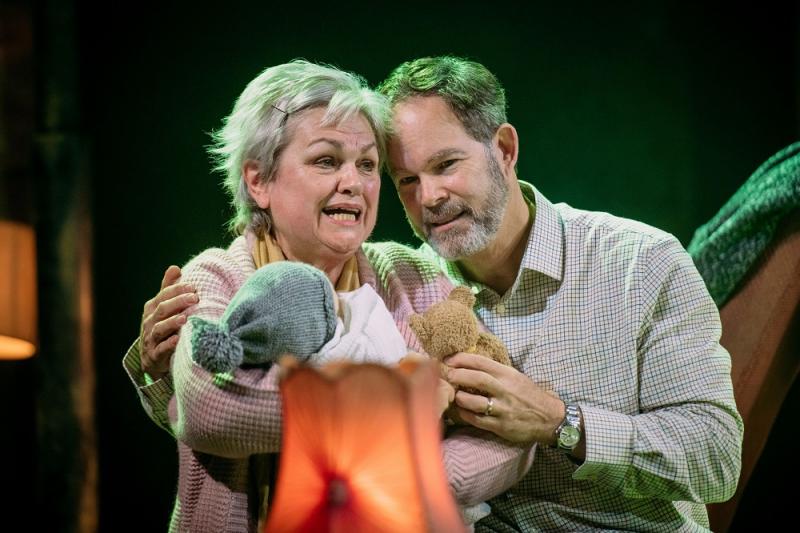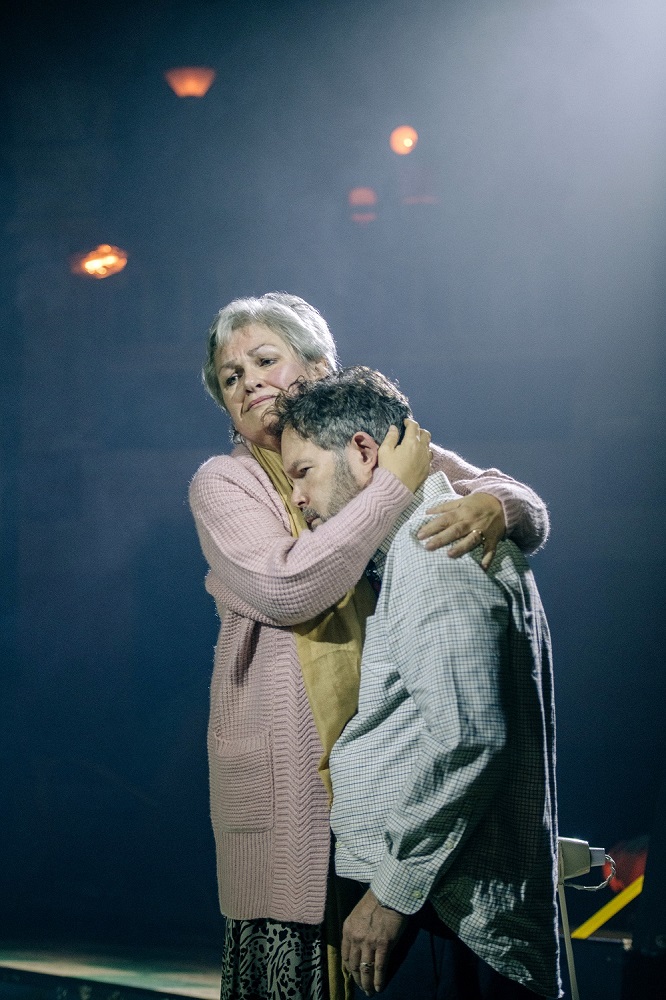Bluebeard's Castle 1: Bullock, Finley, Theatre of Sound, Stone Nest review - scenes from a marriage | reviews, news & interviews
Bluebeard's Castle 1: Bullock, Finley, Theatre of Sound, Stone Nest review - scenes from a marriage
Bluebeard's Castle 1: Bullock, Finley, Theatre of Sound, Stone Nest review - scenes from a marriage
Two great singing actors make an unusual take on Bartók's masterpiece mostly plausible

Which is the locked-in character of the two in Bluebeard’s Castle? In composing his one-act masterpiece of shattering profundity, composer Bartók clearly intended Bluebeard’s as “the tragedy of a soul destined to be alone”; the woman Judith unlocks five doors to his psyche, but two more doors must be left shut.
The execution of this idea can’t fail to be moving in parts, especially given the astonishing performances we saw on Saturday afternoon from Susan Bullock and Gerald Finley – they alternate with Gweneth Ann Rand and Michael Mayes – but inevitably, perhaps, the points of contact between the opera and the concept sometimes have to be forced open.
Certainly you gain almost as much from an intimate staging in an atmospheric setting, with a six-piece ensemble made up of players from the London Sinfonietta, as you lose from the usual experience of the work in concert or standard opera house with full orchestra. Some of Bartók’s special effects for the original tableaux envisaged behind the seven doors are diminished (though not the garden or the pool of tears, where the celesta still plays its spooky part). But the key sonorities of clarinet and horn keep the very Hungarian inflections of the instrumental lines alive.
 It takes at least the first of the revived memories involving five other performers – Evans’s replacement for the symbols of Bluebeard’s soul – to work out the big idea, or at least it did for me: was this Judith remembering an affair her husband had with a younger woman? No, it turned out to be the couple’s pre-nuptial passion. What comes out of the trunk on stage revives chronological key points: husband going off on duty, wedding, childbirth, the zenith of family happiness (the one which didn’t quite achieve the desired effect, though it might on film). Tears of familial bereavement made good sense – you could understand why the husband/Bluebeard wouldn’t want to revisit this one – and the expected revelation of the three other wives carried through the inevitability movingly enough. Frankly, the only thing that could justify Bartók’s shattering last climax would be what we see in Michael Haneke’s film Amour, but the lead up to it forged an unforgettable stage image as the husband only wants the wife to kiss him but she sings insistently of her demand into his mouth. Generally the sense of the awful situation was circular, not a linear ratcheting-up of the tension that you get in the original scenario and its realisation.
It takes at least the first of the revived memories involving five other performers – Evans’s replacement for the symbols of Bluebeard’s soul – to work out the big idea, or at least it did for me: was this Judith remembering an affair her husband had with a younger woman? No, it turned out to be the couple’s pre-nuptial passion. What comes out of the trunk on stage revives chronological key points: husband going off on duty, wedding, childbirth, the zenith of family happiness (the one which didn’t quite achieve the desired effect, though it might on film). Tears of familial bereavement made good sense – you could understand why the husband/Bluebeard wouldn’t want to revisit this one – and the expected revelation of the three other wives carried through the inevitability movingly enough. Frankly, the only thing that could justify Bartók’s shattering last climax would be what we see in Michael Haneke’s film Amour, but the lead up to it forged an unforgettable stage image as the husband only wants the wife to kiss him but she sings insistently of her demand into his mouth. Generally the sense of the awful situation was circular, not a linear ratcheting-up of the tension that you get in the original scenario and its realisation.
Bullock and Finley could not have been more plausible in their realism, though. The luxury of having them perform in this small space is akin to the Liaisons Dangereuses experience of getting Dominic West and Janet McTeer at the Donmar Warehouse on the other side of Charing Cross Road, The soprano’s disturbingly real incarnation of a person with dementia undergoes scrutiny at very close quarters – a future role in film beckons, like Galina Vishneskaya’s amazing performance as Sokurov’s The Mother – and it’s uncannily at odds with the tonal beauty which is still hers, coloured to blend with the instrumental timbres in what becomes the first-born sequence. Finley’s nuances are no less beautiful, the sudden violence and anguish visceral, the intent very different from his recent performance with Karen Cargill's opulent Judith and the London Symphony Orchestra conducted by SImon Rattle (I was very lucky to be there at a time during semi-lockdown when large ensembles couldn't otherwise be experienced). Be careful where you sit, though: with the wind players very loud behind me, even the impeccable diction of the two performers was sometimes smothered.
Kudos to the company for including diversity in the action. I overooked the fact that there is also Judith's Castle, with a score by the singular young composer Electra Perivolanis, featuring Rand, Mayes and four players from the Sinfonietta: there had been a performance two hours earlier, and one more follows at 2pm on 13 November, which I'll endeavour to catch. The possibilities of this former Welsh chapel and famous nightclub as a performance space are very exciting, too.
The future of Arts Journalism
You can stop theartsdesk.com closing!
We urgently need financing to survive. Our fundraising drive has thus far raised £49,000 but we need to reach £100,000 or we will be forced to close. Please contribute here: https://gofund.me/c3f6033d
And if you can forward this information to anyone who might assist, we’d be grateful.

Subscribe to theartsdesk.com
Thank you for continuing to read our work on theartsdesk.com. For unlimited access to every article in its entirety, including our archive of more than 15,000 pieces, we're asking for £5 per month or £40 per year. We feel it's a very good deal, and hope you do too.
To take a subscription now simply click here.
And if you're looking for that extra gift for a friend or family member, why not treat them to a theartsdesk.com gift subscription?
more Opera
 Albert Herring, English National Opera review - a great comedy with depths fully realised
Britten’s delight was never made for the Coliseum, but it works on its first outing there
Albert Herring, English National Opera review - a great comedy with depths fully realised
Britten’s delight was never made for the Coliseum, but it works on its first outing there
 Carmen, English National Opera review - not quite dangerous
Hopes for Niamh O’Sullivan only partly fulfilled, though much good singing throughout
Carmen, English National Opera review - not quite dangerous
Hopes for Niamh O’Sullivan only partly fulfilled, though much good singing throughout
 Giustino, Linbury Theatre review - a stylish account of a slight opera
Gods, mortals and monsters do battle in Handel's charming drama
Giustino, Linbury Theatre review - a stylish account of a slight opera
Gods, mortals and monsters do battle in Handel's charming drama
 Susanna, Opera North review - hybrid staging of a Handel oratorio
Dance and signing complement outstanding singing in a story of virtue rewarded
Susanna, Opera North review - hybrid staging of a Handel oratorio
Dance and signing complement outstanding singing in a story of virtue rewarded
 Ariodante, Opéra Garnier, Paris review - a blast of Baroque beauty
A near-perfect night at the opera
Ariodante, Opéra Garnier, Paris review - a blast of Baroque beauty
A near-perfect night at the opera
 Cinderella/La Cenerentola, English National Opera review - the truth behind the tinsel
Appealing performances cut through hyperactive stagecraft
Cinderella/La Cenerentola, English National Opera review - the truth behind the tinsel
Appealing performances cut through hyperactive stagecraft
 Tosca, Royal Opera review - Ailyn Pérez steps in as the most vivid of divas
Jakub Hrůša’s multicoloured Puccini last night found a soprano to match
Tosca, Royal Opera review - Ailyn Pérez steps in as the most vivid of divas
Jakub Hrůša’s multicoloured Puccini last night found a soprano to match
 Tosca, Welsh National Opera review - a great company reduced to brilliance
The old warhorse made special by the basics
Tosca, Welsh National Opera review - a great company reduced to brilliance
The old warhorse made special by the basics
 BBC Proms: The Marriage of Figaro, Glyndebourne Festival review - merriment and menace
Strong Proms transfer for a robust and affecting show
BBC Proms: The Marriage of Figaro, Glyndebourne Festival review - merriment and menace
Strong Proms transfer for a robust and affecting show
 BBC Proms: Suor Angelica, LSO, Pappano review - earthly passion, heavenly grief
A Sister to remember blesses Puccini's convent tragedy
BBC Proms: Suor Angelica, LSO, Pappano review - earthly passion, heavenly grief
A Sister to remember blesses Puccini's convent tragedy
 Orpheus and Eurydice, Opera Queensland/SCO, Edinburgh International Festival 2025 review - dazzling, but distracting
Eye-popping acrobatics don’t always assist in Gluck’s quest for operatic truth
Orpheus and Eurydice, Opera Queensland/SCO, Edinburgh International Festival 2025 review - dazzling, but distracting
Eye-popping acrobatics don’t always assist in Gluck’s quest for operatic truth
 MARS, Irish National Opera review - silly space oddity with fun stretches
Cast, orchestra and production give Jennifer Walshe’s bold collage their all
MARS, Irish National Opera review - silly space oddity with fun stretches
Cast, orchestra and production give Jennifer Walshe’s bold collage their all

Add comment